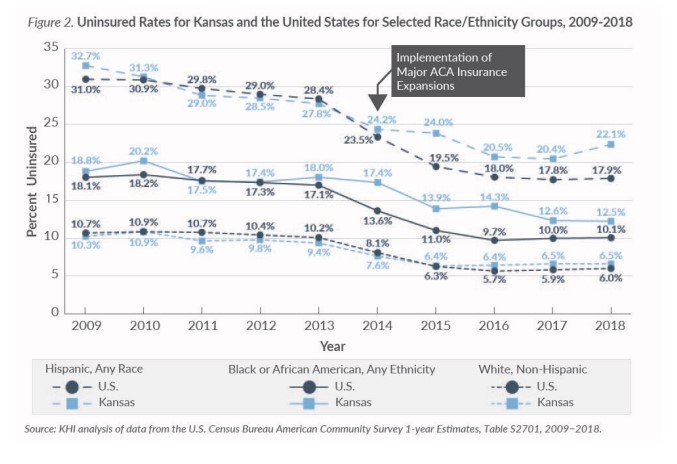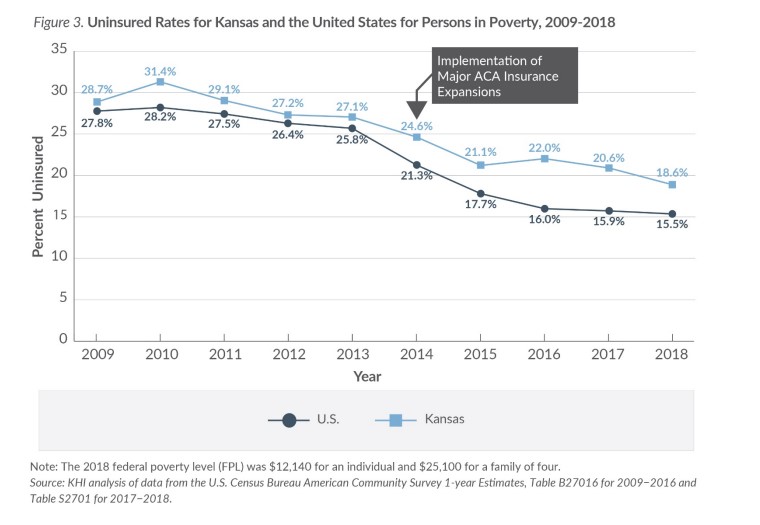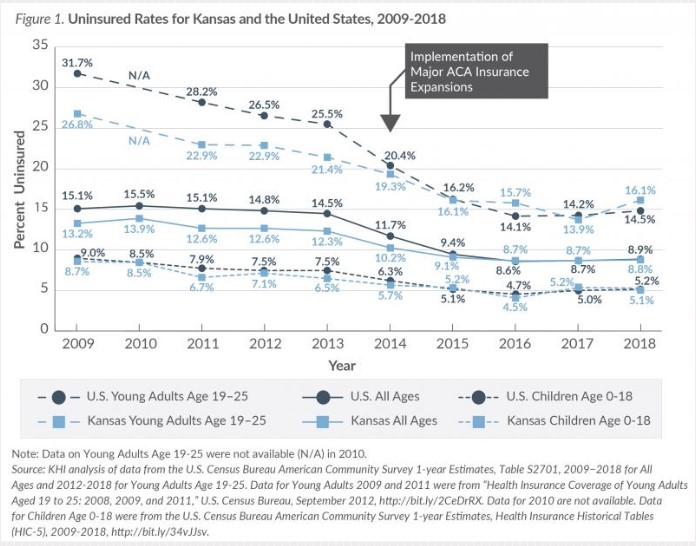In late October, the U.S. Census Bureau released its latest estimates on health insurance coverage. In 2018, the overall uninsured rates in Kansas and the U.S. (Figure 1) were similar. However, the similar rates at the present time do not tell the story of the important changes that have occurred over the last 5-10 years. Furthermore, looking only at the overall uninsured rate masks important differences that still exist for some vulnerable groups in Kansas.
Prior to about 2014, the uninsured rate in Kansas was better than that in the U.S. as a whole (Figure 1). While the uninsured rate in Kansas continued to decline after 2014, it did not improve as fast as the overall U.S. uninsured rate. Most states expanded Medicaid in 2014 as allowed by the Affordable Care Act (ACA) and as a result the national uninsured rate dropped significantly. Many studies have shown that the uninsured rate dropped much more quickly in expansion states than in non-expansion states, including Kansas. As a result, after many years of having a better than average uninsured rate, the uninsured rate in Kansas is now essentially the same as the U.S. rate.
As mentioned, the uninsured rate in Kansas and other non-expansion states did decline after 2014, but not because of Medicaid expansion. Rather the decline was due to improving economic conditions and the other major insurance expansion provisions in the ACA, including removing any preexisting condition exclusions, the opening of the health insurance marketplaces, the individual and employer mandates, and all of the public discussion around health insurance.
Another important finding in the current data on uninsured rates in Kansas is that some vulnerable groups fare less well in Kansas than in the U.S. as a whole. For example, among young adults in Kansas, 16.1 percent were uninsured in 2018, higher than the U.S. rate of 14.5 percent – a dramatic reversal from the pre-2014 years when young adults in Kansas had much lower uninsured rates than their peers nationally.
Looking at other groups such as racial and ethnic minorities, or those living in poverty, the uninsured rates in Kansas are significantly higher than in the U.S. as a whole. Among Hispanics, Any Race, living in Kansas the uninsured rate was 22.1 percent in 2018, nearly one-fourth higher than the U.S. rate of 17.9 percent (Figure 2). Similarly, for Black, any ethnicity, Kansans the uninsured rate in 2018 was 12.5 percent, again almost one-fourth higher than the U.S. rate of 10.1 percent. For Kansans living in poverty, the uninsured rate in 2018 was 18.6 percent, one-fifth higher than the U.S. rate of 15.5 percent (Figure 3).


Yet, non-Hispanic Whites in Kansas also fare worse than those in the U.S. as a whole. In 2018, the uninsured rate among non-Hispanic Whites in Kansas was 6.5 percent compared to 6.0 percent for the U.S. (Figure 1).
So if the uninsured rate in Kansas for each of these racial/ethnic groups is worse, how is the overall uninsured rate in Kansas still comparable to that of the U.S.? Since the share of the population in Kansas that is minority is smaller than in the U.S., the overall average uninsured rates turn out to be similar – despite the fact that each group individually fares worse.
As in the U.S. as whole, within Kansas, the uninsured rate among minorities is much higher than among non-Hispanic Whites. In 2018, the uninsured rate for Hispanic, Any Race, Kansans was 3.4 time higher than among non-Hispanic Whites (22.1 v. 6.5 percent) and for Blacks, any ethnicity, it was nearly double (12.5 v. 6.5 percent) (Figure 2).
A close examination of current data on uninsured rates in Kansas makes it clear that while progress has been made, as a state we are losing ground to our counterparts around the country. And dramatic disparities still exist among some of our vulnerable, fellow Kansans.
Notes:
This year, the U.S. Census Bureau released its latest American Community Survey 1-Year Estimates in several waves. Data released in September allowed KHI to compare the overall uninsured rate in Kansas and the United States and trends over time but didn’t allow comparisons for population subgroups. This document analyzes the October data release, which included the statistical tests needed to compare rates and trends over time for population groups of interest in Kansas and the United States. The U.S. Census Bureau will release additional data in the future. Please check our website frequently for more information.
